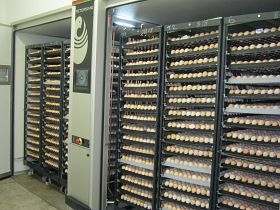What is a Hatchery?
A hatchery is a place where fertile eggs are hatched, most particularly on a business basis. It could be referred to as the maternity center where chicks are produced from fertile chicken eggs. Hatchery technology is the technique or method of using incubators to incubate and hatch fertile eggs.
What are the Benefits or Advantages of Hatchery Business?
The hatchery business has a few benefits, and they include:
- It provides income and employment opportunities.
- You don’t need a large space before you can establish an egg or chicken hatchery.
- You can incubate and hatch the eggs of other poultry species like quail, turkey, goose, duck, etc. You’re not limited to chickens alone.
- You’re able to prevent wastages of hatchable eggs.
- You can synchronize your egg hatching schedule in order to have chicks available at the desired periods.
While the hatchery business has its merits, it has some limitations that make it a no-no for most people. These limitations include:
i. High cost of establishment. The machinery, equipment and infrastructure for hatchery are quite expensive. So much capital is required to start the business.
ii. Scarcity of spare parts. Getting spare parts to replace damaged parts could be difficult, especially in developing countries. Sometimes, some machines become obsolete and the manufacturers would have stopped further production of such model.
iii. Diseases prevalence: Where hatchery-borne diseases are prevalent, the hatchery business will be greatly impacted. This includes the problem of low hatchability rate which leads to financial losses.
Steps to Take When Establishing a Hatchery
There are six major steps to take if you’re planning to establish a commercial hatchery. They are:
- Conduct a feasibility study for the project
- Proceed with the land acquisition if no.1 is favorable.
- Construct the required structures and infrastructures
- Procure and install the necessary machines and equipment.
- Design your organizational chart and recruit the hatchery workers
- Procure fertile eggs to start business operations fully.
Feasibility Study for the Hatchery Project
A feasibility study is highly important because it will help you to determine if it is profitable or unprofitable to go ahead with the hatchery project. Other information that the study will provide are:
- The availability or level of demand for day-old chicks (DOC) in such location or area.
- The availability and prices of machines, equipment and other necessary inputs for hatchery operations.
- Existing problems and challenges surrounding the business and how they can be overcome.
- The financial or cost analysis, showing if the project will make a profit or not.
When conducting the feasibility study, endeavor to visit existing hatcheries around to gather important information such as models and prices of incubators, fertile eggs, generators and other necessary equipment. You can also request or places where you can get egg incubators for sale. Also, visit poultry farmers to know where and how they source for their DOC and how it was easy procuring them.
Land Acquisition for the Hatchery Business
Before you acquire the land on which you will be establishing your hatchery, you must consider the size of the proposed hatchery. That is to say; you must know the number of chicks you plan to hatch each week. A big or huge hatchery demands a large piece of land because it needs more structures, infrastructures and offices. There are some things you must consider when choosing the hatchery location and land.
- The hatchery should not be located close to poultry houses or pens to prevent diseases transmission. It is safe to give a minimum distance of 150 meters between a hatchery and poultry far or house.
- The hatchery should not be sited in residential areas to avoid pollution and diseases transmission.
- It should not be located near roads or places where heavy machines or equipment that cause vibration are used. This is because occasional vibrations affect the development of embryos.
- The hatchery should be sited in an area which has good, smooth roads for smooth transportation of eggs and chicks.
- It should not be located on marshy or water-logged land.
- The area should have constant electricity and water supply.
Construction of Hatchery Structures and Infrastructures
After acquiring the most suitable land for the hatchery business, the next step is to build the necessary structures and put in place vital infrastructures. The necessary structures are;
- Incubator house
- Office or administrative buildings
- Equipment store
- Cloakroom
- Restrooms and bathrooms
- Perimeter fence
The infrastructures are:
- Borehole or well
- Incinerator
- Roads
- Parking spaces
Procurement and Installations of Machines and Equipment
When the structures are in place, the next step is to buy all necessary machines and equipment which include incubators, generators, air conditioners, fans, egg crates, pumping machines and vehicles. Ensure that experts or professionals install these. You should also patronize genuine dealers or directly from the manufacturers.
Hatchery Staff Recruitment
You need to recruit both technical and administrative workers to handle various operations in the hatchery. The following are needed in a typical commercial hatchery:
- Hatchery manager
- Hatchery supervisors
- Administrative officer
- Accountant
- Clerks
- Technicians
- Hatchery Attendants
- Security guards and gardeners
Procurement of Fertile or Hatchable Eggs
After all the required machines and equipment are in place, the next important step to take is to decide how hatchable eggs will be procured. There are two ways to procure fertile eggs. You can establish a parent stock farm for your hatchery; or buy the eggs directly or indirectly from another parent-stock farm.
Procuring your eggs from the parent-stock farm of the hatchery has its own advantages and disadvantages. The advantages include:
- The eggs’ quality can be ascertained
- Regular supply of hatchable eggs
- Reduced cost of procuring eggs, hence, hatching cost is reduced
- Cross farm transmission or transfer of diseases is eliminated.
The disadvantages of this procurement method include:
- If the parent-stock farm is not well-managed, the operations or running of the hatchery could be adversely affected.
- High possibility of disease transfer from the parent-stock farm to the hatchery.
Direct purchase of hatchable eggs involves buying from a parent-stock farm directly. The parent-stock farm could even be delivering the eggs directly to the hatchery.
Indirect purchase of eggs could be made via contract. An intermediary will be involved. The middleman links the hatchery with various parent-stock farms, and he is responsible for the supply of the eggs. Before you deal with an intermediary, ensure you conduct adequate research on his trustworthiness and reliability. This is very important.





Is it posdible for you to help with a business plan
Good Day, please can you help me on where to get the hatch able eggs.
Reach out to me via this contact page
can I be able to get fertilized eggs especially broiler ones for hatching?
Yes, some breeders sell fertilised eggs